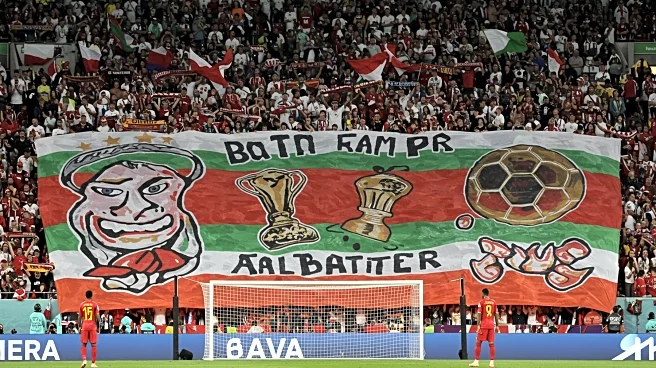What's Happening?
Manchester City fans unveiled a tifo banner during the Premier League's opening weekend, mocking Real Madrid's reaction to Vinicius Junior missing out on the Ballon d'Or. The banner featured Oasis lyrics 'Stop crying your heart out' alongside an image of Rodri kissing the trophy. Tifos, large banners or coordinated flag displays, originated in Italy and southern Europe as a way for fans to express support for their teams. They are becoming more common in English football, with several clubs displaying notable tifos during the first few days of the 2025/26 season.
Why It's Important?
The use of tifos in English football represents a cultural shift, as these displays have been popular in mainland Europe and the Americas for decades. Manchester City's tifo not only showcases fan creativity but also highlights the competitive nature of football rivalries. Such displays can enhance the atmosphere at matches and strengthen fan engagement, potentially influencing club branding and marketing strategies. The growing popularity of tifos in the Premier League may lead to increased investment in fan-driven initiatives and stadium experiences.
What's Next?
As tifos become more prevalent in English football, clubs may explore new ways to incorporate fan creativity into matchday experiences. This could involve collaborations with artists or designers to create unique displays that resonate with supporters. Additionally, the Premier League might consider formalizing guidelines for tifo displays to ensure safety and inclusivity. The trend could also inspire other sports leagues to adopt similar fan engagement strategies, enhancing the overall spectator experience.
Beyond the Headlines
The rise of tifos in English football could have broader implications for fan culture and community building. These displays offer a platform for fans to express their identity and solidarity, potentially fostering a sense of belonging and loyalty. As clubs embrace tifos, they may also need to navigate ethical considerations, such as ensuring that messages are respectful and do not incite violence or discrimination. The integration of tifos into football culture could lead to long-term shifts in how fans interact with their teams and each other.












